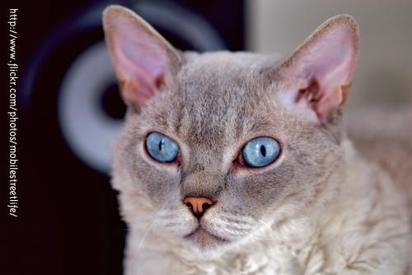
When a rescue cat gave birth to a litter of five in Montana, USA in 1987, it was immediately realised that one of the litter was different. Unlike the others, this cat had a thick, curly coat that was the result of a genetic mutation. Breeder Jeri Newman was fascinated to find out whether this cat carried the Rex gene, like the Devon and Cornish Rex that both possessed a diminished coat. She soon discovered that the cat carried an altogether different Rex gene that meant the coat was curly but of a normal length. Newman named this cat Miss DePesto and bred her to a black Persian, producing a litter of straight-haired and Rex kittens. Miss DePesto is thought of as the foundation stock of the Selkirk Rex, from whence every generation derives. The breed is recognised by the International Cat Association (1992), the American Cat Fanciers Association (1998) and the Cat Fanciers Association (2000).
Various breeds have been out-crossed in the Selkirk Rex’s breeding program, including Persians, Shorthairs, Exotics and Himalayans. This has given rise to a spectrum of variations in the breed in terms of appearance, structure and behavioural traits. Generally speaking, the Selkirk Rex is highly distinctive, despite being often mistaken for the La Perm, and is characterised by either a long or short coat, a rounded face and nose, a muscular body structure, wide eyes and nimble legs. The coat itself is plush and has a woolly appearance, and can be maintained easily with grooming (note: grooming too regularly can relax the curls and ruin the unique appearance of the cat). All coat colours are permissible in the breed, from solid colours of chocolate and lilac, to bi-colours of silver and smoke.
The Selkirk Rex is an intelligent and curious breed that benefits from mental as well as physical enrichment in its everyday life. Although it is not demanding of attention, it does appreciate plenty of human companionship throughout the day and dislikes being left alone for long periods of time. Breeders, owners and enthusiasts have described the Selkirk Rex as a gentle, patient and devoted cat that forms strong attachments to its people and is compatible with children and other house pets. The Selkirk’s sociable nature means it responds well to strangers and is never unduly shy or aggressive. On average, a healthy Selkirk Rex will weigh 10-12 pounds, with a typical life expectancy of 15 years.
The Selkirk Rex is thought of as a healthy and resilient breed, although due to the various out-crosses that have contributed to its development, certain health conditions are documented. Hypertrophic cardiomyopathy, the most common type of heart disease in cats, as well as polycystic kidney disease, are two serious complaints observed in the breed. Besides this, aural problems resulting from curly hair growing in the eye canal, dermatitis, and hip dysplasia are also prevalent.
Do you own a Selkirk Rex? Let others know what they're like!
Related products
Advantage 80 Spot On Flea Control Large Cats and Rabbits
from £12.95
Advantage 40 Spot On Flea Control Cats, Small Dogs and Rabbits
from £12.95
Advantage 100 Spot On Flea Control Medium Dog
from £12.95
Advantage 250 Spot On Flea Control Large Dog
from £12.95
Drontal Tasty Bone Wormer Tablets for Small & Medium Dogs (2 to 20kg)
from £2.15
FRONTLINE Plus Flea & Tick Treatment Dogs & Cats
from £17.49
TermaWorm™ Tablets for Cats & Dogs
from £1.59
Drontal Tasty Bone XL Wormer Tablets for Large Dogs (Over 20kg)
from £6.39